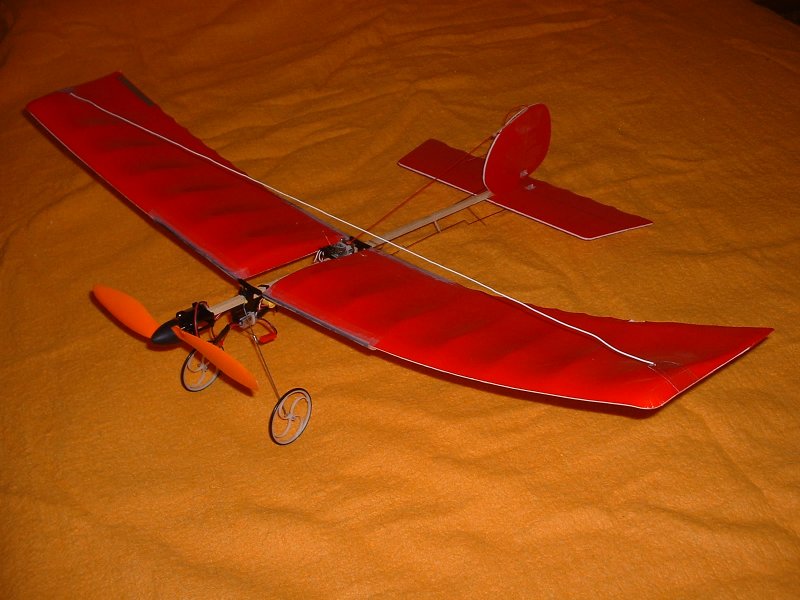
Mark's aircraft
home aircraft books history links old
news quotes soft sounds
weather
page updated:
2010.01.02
aircraft - indoor - pico stick
early electric power gliders helicopter indoor technology future
hornet swift pico stick indoor thing

selection
The default indoor aircraft. I resisted for a while, but the pylon racing looked like too much fun.
construction
2 piece white wings formed out
of that stuff they sell burgers in, finished in red on the top.
Ribs and a profile wing section are formed to give it a bit of
rigidity. Unfortunately my wing panels are not well matched - the
left wing being weaker and bending more under the tension of the
dihedral rigging. Joined to the plastic stick brackets with 3mm
wooden dowels front and back, which I replaced with carbon fibre.
I also used some wider tape to fix these to the wings using the
strange clear glue supplied.
Tailplane and fin of similar material to the wing, but flat and
finished in red on both sides, and stuck to the stick. The
control surfaces are formed by crushing 1 side of the sandwich,
leaving the other to form the hinge. Plastic control horns pushed
through slots and retained only with push on clips over ridges.
Everything else slides onto the stick. I put a small servo screw
through the motor/gearbox tube to prevent it pulling off in
flight. I added a cross piece to the wire undercarriage, making
an A frame to stiffen it up a bit, as the standard seems very
floppy. The 7x cell 8.4V 250mAh nicad pack hangs in rubber bands
inside a plastic frame, which also carries the speed controller
and the front of the servos, with another small frame taking the
rear.
The servo location needs a bit of thought to avoid awkward
control runs unless you use a computer Tx. The piano wire push
rod material is not a good fit in the servo arms and control
horns, but the next size up would be too big and heavy. The push
rods need to be formed so that they pass through the guide
correctly to avoid binding.
The Rx is just cable tied onto the stick between the wings. The
exact position of the wings on the stick is flexible to allow the
centre of gravity to be moved without adding weight. In practice
the setup in the instructions is about right, and quite a lot of
adjustment is possible just by moving the flight power pack.
flight
The 1st idoor session after I
finshed it was in a very small hall, with onlookers along most of
the walls. I decided not to risk it, but still flew the hornet. I
initially rigged the dihedral with a bit of thread, but replaced
that with a bit of single core bell wire, as the loads are quite
high.
Next chance to fly was at the 2002 February pylon session. I had
a bit of practice 1st. It flew pretty well straight away. I
tighten the dihedral wire even more. Everyone gets this wrong -
you need a serious amount of dihedral to stand a chance of making
the tight turns required indoor. At my 1st attempt I managed 3rd
place in the 1st round, but didn't make the final, getting
knocked out of the air in the 2nd round. Only minor damage, but
the power got disconnected.
2002 March I managed 2nd place in the final.

2002 April I managed 2nd place
again, despite a mid air after 5 laps.
2002 May flew it at Wolston including Carol having a go through
the trainer lead.
2002 June we had a bit of "unofficial" pylon racing on
the field outside the club meeting, which I managed to win.
2002 August a timed spot landing competition at the club meeting
which I won.
2002 October 1st indoor session a few flights, but no racing.
2002 November made the pylon final, but clipped the far pylon,
breaking the rear wing joiner. No points as an unusual 4 in the
final.
2002 December as a break from pylon we had a limbo event instead.
I managed 14 passes in 60secs under the tape strung between the
pylons, which put me 1st.


retirement
There's only so much you can do with an underpowered rudder/elevator aircraft. I got a bit bored with it. Also looks a bit tatty round the edges, from various mid airs. I reused many of the bits on the new indoor thing. Still have all the bits though, so it could fly again.
after I finshed it was in a very small hall, with onlookers along most of the walls. I decided not to
statistics
| span | area | mass dry |
mass power |
loading |
| cm | cm2 | 150g | 200g | g/dm2 |
| in | ft2 | oz | oz/ft2 |
Here are some more photos.
and video